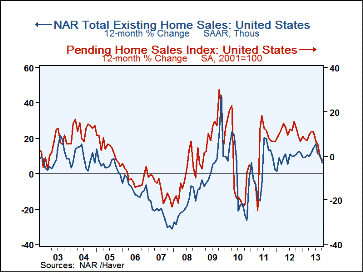 Global| Nov 25 2013
Global| Nov 25 2013U.S. Pending Home Sales Continue to Erode
Summary
Pending home sales continue to show weakness. The number of homes on the market for sales has dropped for five straight months. The number of homes for sale has contracted by 1.2% over the past year. There are still year-over-year [...]
 Pending home sales continue to show weakness. The number of homes on the market for sales has dropped for five straight months. The number of homes for sale has contracted by 1.2% over the past year. There are still year-over-year increases in homes for sale in the Northeast and the Midwest. But in the South and the West, the numbers have shrunk.
Pending home sales continue to show weakness. The number of homes on the market for sales has dropped for five straight months. The number of homes for sale has contracted by 1.2% over the past year. There are still year-over-year increases in homes for sale in the Northeast and the Midwest. But in the South and the West, the numbers have shrunk.
In all regions, sales are lower over six months. Sales are lower over three months in the Midwest, the South and the West with only the tiny Northeast showing a gain.
Pending home sales are usually stronger than actual existing home sales. When the gap between the growth rates of the two series is squeezed, as it is now, that is usually a sign of more weakness to come.
The entire housing sector has slowed. Both new and existing home sales have slowed. In response, people are less eager to put their houses on the market and the growth of pending homes for sale has slowed. But house prices are still rising year-over-year. There is still an attraction to selling. But year-over-year house prices are rising much more slowly than they once were, another sign of a loss of vigor in the sector.
Both housing sales and pending sales have slowed. House prices which are still rising are showing signs of slowing momentum. In the winter months, sales usually slow and the market becomes less of harbinger. Most sales are in the summer at that time we get our best readings on the health of the market. Even though data are seasonally adjusted, the quality of the signal in the winder is poor. Even so, there are some clear signs of housing losing momentum that should not be ignored.
Implications for policy
Early in the expansion, the Federal Reserve had looked to housing to carry the overall economic recovery forward. Now with housing losing its zest, other sectors will have to step in. Job growth has stabilized to some extent, but it is still unclear what level of growth will persist. There is some danger that the rise in interest rates combined with still high rates of unemployment are not leaving much in the way of solid fundamentals to support housing. Higher prices for homes, while good for homeowners, at some point make housing unaffordable. At the same time mortgage rates have risen. Housing now seems to have more headwinds than tail winds. And it is still an important sector for the economy. It just isn't doing as well as it once did.

Robert Brusca
AuthorMore in Author Profile »Robert A. Brusca is Chief Economist of Fact and Opinion Economics, a consulting firm he founded in Manhattan. He has been an economist on Wall Street for over 25 years. He has visited central banking and large institutional clients in over 30 countries in his career as an economist. Mr. Brusca was a Divisional Research Chief at the Federal Reserve Bank of NY (Chief of the International Financial markets Division), a Fed Watcher at Irving Trust and Chief Economist at Nikko Securities International. He is widely quoted and appears in various media. Mr. Brusca holds an MA and Ph.D. in economics from Michigan State University and a BA in Economics from the University of Michigan. His research pursues his strong interests in non aligned policy economics as well as international economics. FAO Economics’ research targets investors to assist them in making better investment decisions in stocks, bonds and in a variety of international assets. The company does not manage money and has no conflicts in giving economic advice.






